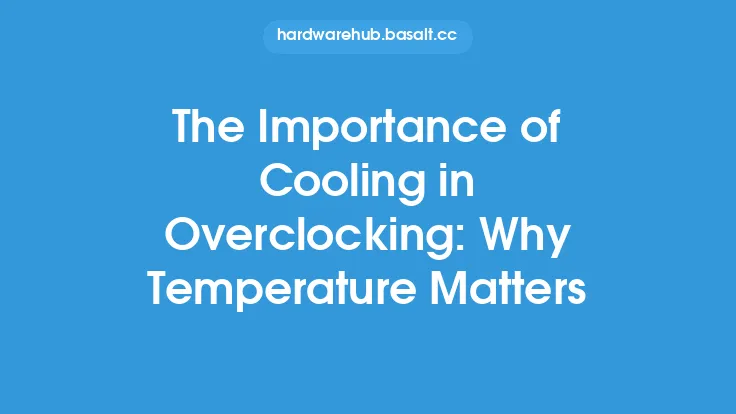When it comes to extreme overclocking, the role of cooling cannot be overstated. As enthusiasts push the limits of their hardware to achieve unprecedented levels of performance, the importance of effective cooling becomes increasingly critical. In this realm, even the slightest increase in temperature can have a profound impact on the stability and longevity of the system. As such, a deep understanding of the cooling principles and technologies involved is essential for anyone looking to venture into the world of extreme overclocking.
Introduction to Extreme Overclocking Cooling
Extreme overclocking is all about squeezing every last bit of performance out of a system, often by pushing the hardware beyond its specified limits. This can involve increasing the clock speeds of the CPU, GPU, and other components, as well as tweaking voltages and other settings to optimize performance. However, as the system is pushed to its limits, heat generation increases exponentially, making cooling a major bottleneck. Effective cooling is essential to prevent overheating, which can lead to system crashes, data corruption, and even permanent damage to the hardware.
Cooling Technologies for Extreme Overclocking
There are several cooling technologies that are commonly used in extreme overclocking, each with its own strengths and weaknesses. Air cooling, which uses fans to dissipate heat from the system, is often insufficient for extreme overclocking due to its limited cooling capacity. Liquid cooling, on the other hand, uses a liquid coolant to absorb heat from the system and transfer it to a radiator, where it is dissipated. This method is generally more effective than air cooling and is widely used in extreme overclocking. However, it can be more complex and expensive to implement.
Phase Change Cooling and Extreme Overclocking
Phase change cooling, also known as vapor chamber cooling, is a more advanced cooling technology that uses a phase change material to absorb and dissipate heat. This method is highly effective and is often used in high-performance systems, including those used for extreme overclocking. Phase change cooling works by using a material that changes phase (i.e., from solid to liquid or from liquid to gas) as it absorbs heat, allowing for highly efficient heat transfer. This method is particularly useful for extreme overclocking, as it can provide a high level of cooling performance while minimizing the risk of overheating.
Cryogenic Cooling and Extreme Overclocking
Cryogenic cooling, which uses extremely low temperatures to cool the system, is another method that is sometimes used in extreme overclocking. This method involves using liquid nitrogen or other cryogenic fluids to cool the system to temperatures that are often below -100°C. Cryogenic cooling can provide an extremely high level of cooling performance, making it possible to achieve clock speeds that would be impossible with other cooling methods. However, it is also highly complex and expensive, and requires specialized equipment and expertise.
Custom Cooling Solutions for Extreme Overclocking
In addition to these established cooling technologies, many extreme overclockers also use custom cooling solutions that are tailored to their specific needs. These solutions can involve modifying existing cooling systems or designing entirely new ones from scratch. Custom cooling solutions can provide a high level of flexibility and performance, allowing enthusiasts to push their systems to the limits of what is possible. However, they can also be highly complex and require a significant amount of expertise and resources to design and implement.
The Importance of Cooling System Maintenance
Regardless of the cooling technology used, maintenance is critical to ensuring optimal performance and preventing overheating. This includes regularly cleaning the cooling system to prevent dust buildup, checking for leaks and other issues, and monitoring system temperatures to ensure that they are within a safe range. In extreme overclocking, even small increases in temperature can have a significant impact on system stability and performance, making maintenance a critical aspect of the overclocking process.
Overclocking Cooling and System Design
The design of the system itself also plays a critical role in extreme overclocking. This includes the choice of components, the layout of the system, and the materials used in its construction. A well-designed system can provide a high level of cooling performance while minimizing the risk of overheating, while a poorly designed system can lead to cooling bottlenecks and reduced performance. As such, system design is a critical aspect of extreme overclocking, and enthusiasts must carefully consider a range of factors when building and optimizing their systems.
Conclusion
In conclusion, cooling plays a critical role in extreme overclocking, and a deep understanding of the cooling principles and technologies involved is essential for anyone looking to push their system to the limits of performance. By choosing the right cooling technology, designing a well-optimized system, and maintaining the cooling system over time, enthusiasts can achieve unprecedented levels of performance while minimizing the risk of overheating and system damage. Whether using established cooling technologies or custom solutions, the key to success in extreme overclocking is a thorough understanding of the complex interplay between cooling, system design, and performance.





